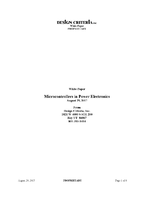Physical Process Modeling Software has heat transfer module.
Press Release Summary:
FEMLAB multiphysics package includes dedicated Heat Transfer Module that provides users with surface-to-surface radiation, non-isothermal flow, and bioheat equation heat analysis capabilities. Add-on module also lets users model multiple physics simultaneously. Accompanying Model Library has over 20 ready-to-run model files that show how to investigate heat transfer types and provides base of examples that can be tailored to application requirements.
Original Press Release:
FEMLAB® Heat Transfer Module Simulates Complex Temperature Fields in Parallel with Other Physics
The new add-on for FEMLAB multiphysics package introduces surface-to-surface radiation and new modeling interfaces for heat transfer through conduction and convection. Application modes supply tailored graphical interfaces for the quick, easy manipulation of the governing equations for general heat transfer, non-isothermal flow, highly conductive layers and even the bioheat equation.
BURLINGTON, MA (November 3, 2004)-Heat transfer is involved in almost every kind of physical process and in fact can be the limiting factor for many of them. Thus its study is of vital importance, and the requirement for powerful heat-transfer analysis tools is virtually universal. Responding to this need, Comsol has greatly expanded the base capabilities available in the core FEMLAB package and created a dedicated Heat Transfer Module. It not only adds new types of heat analysis such as surface-to-surface radiation, non-isothermal flow and the bioheat equation, it gives extra power to the general heat equation so it's easier for users to get more realistic results from their simulations. Further, heat seldom exists as an isolated physics and arises through other interactions, and FEMLAB excels at letting scientists and engineers model multiple physics simultaneously, putting heat transfer in the context of real-world situations. A final highlight is an accompanying Model Library, which consists of more than 20 advanced, ready-to-run model files. They not only show users how to investigate various types of heat transfer in a multiphysics setting, it also provides a base of examples they can tailor to their own application requirements.
The Heat Transfer Module works as an add-on to the core FEMLAB package, which itself is a sophisticated tool for modeling and simulating any physical process you can describe with partial differential equations (PDEs). It comes with a CAD editor and high-performance state-of-the-art solvers that address extremely large problems yet quickly yield accurate results. Working in an easy-to-use graphical interface, users choose from several ways to describe their problems in 1D, 2D and 3D. A particular strength of the package is its PDE modeling capability, whereby it can link and solve coupled equations from arbitrary fields. Flexible postprocessing and visualization tools round out the package's extensive capabilities.
Using the application modes in the Heat Transfer Module along with FEMLAB's inherent multiphysics capabilities, researchers can model a temperature field in parallel with other physics. These modes support all fundamental mechanisms: conductive, convective and radiative heat transfer. That latter mode is important because radiation is so prevalent, even at low temperatures; the module supports both surface-surface and surface-ambient radiation, even in three dimensions. Finally, the module also provides special modeling techniques that handle non-isothermal flow for dealing with a fluid's density change with temperature, and for handling highly conductive thin layers, which can often be a high hurdle for other modeling packages.
Although it's possible to set up a heat-transfer or multiphysics simulation using these predefined application modes, COMSOL further eases the modeling process and allows scientists to more quickly get results thanks to a Model Library that ships with the module. It consists of both a separate book and a set of more than 20 model files users can load directly into FEMLAB. These models not only explain the physical phenomena that underlie heat transfer, they also illustrate the techniques for applying this knowledge to advanced real-world problems. Thus, this book serves as a valuable reference work in its own right, just as well suited for the classroom as for the R&D laboratory.
Strengths in Key Application Areas
These predefined application modes and the Model Library enable the Heat Transfer Module to make substantial contributions to understanding the underlying phenomena in many fields of research as well as helping to improve product design and manufacturing in almost any industry. However, the product excels at this task in three particular areas:
Thermal management in electronics
An important aspect in electronic system design is the cooling required to keep a circuit assembly within its specified operating temperature range; similarly, in the manufacturing of silicon wafers it's crucial to maintain a uniform temperature distribution to achieve high yields. In the second case, the manufacturing process takes place at very low pressures, which means that radiation becomes the main heat transfer mechanism and surface-to-surface radiation becomes necessary for its modeling. Heat transfer also plays a key role in the interaction between electronic devices and live tissue. A common denominator for this application area is that the models usually involve coupled heat transfer in both solids and fluids.
Thermal processes and manufacturing
In the thermal-processing and manufacturing industries phase changes are often a critical aspect of fabrication. These phase transformations can be relevant in everything from copper casting and welding in metallurgy, to food preparation and cooking in the food industry. In metallurgy, the high temperatures imply that surface-to-surface-radiation has to be accounted for in the modeling process, a feature available in the new Heat Transfer Module. A common denominator in these modeling problems is the nonlinearities that arise from phase changes.
Medical technology and bioengineering
Accurately describing heat transfer in live tissue is usually done with the bioheat equation, where effective transport properties and temperature sinks and sources are available for different types of live tissue. Using this module, scientists can investigate a wide range of problems from the development of dose planning in microwave-coagulation therapy for cancer treatment, to the design of treatment devices that interact with human tissue. A common denominator for this class of problems is the interaction of heat-generating or -consuming devices with live tissue.
System requirements
The Heat Transfer Module requires FEMLAB 3.1, which runs under Windows 98/2000/NT 4.0/XP as well as Linux, Solaris and HP-UX. 64-bit support is available under Linux (running on the AMD64 and Itanium processors), and under UNIX (for the Solaris and HP-UX operating systems). The minimum system configuration is a Pentium processor, 256M bytes of RAM (512M bytes recommended) and an OpenGL-compatible graphics card.
Price and availability
The Heat Transfer Module lists for $2,995, while a single-user perpetual license for FEMLAB 3.1 lists for $6,995 including first-class support and automatic upgrades for 12 months; special academic pricing is available. Production deliveries begin in October 2004. The software will be available from COMSOL as well as through its distributors around the world. Full details about the product and distribution outlets are available on the firm's web site at www.comsol.com.
About COMSOL
COMSOL was founded in 1986 in Stockholm, Sweden, and has grown to include offices in Benelux, Denmark, Finland, France, Germany Norway, Switzerland, the United Kingdom, and a US presence with offices in Burlington, MA, and Los Angeles, CA. Additional information about the company is available at www.comsol.com.
TRADEMARKS
FEMLAB is a registered trademark of COMSOL AB. All other trademarks and registered trademarks are the property of their respective owners.




